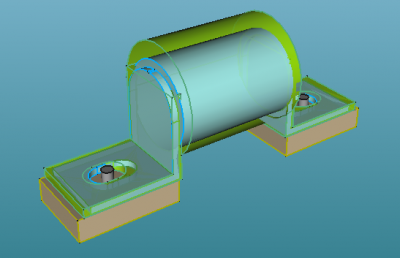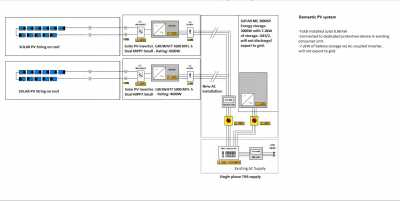@transparent I think what this key does is to enable SolarEdge optimisers to work with non-SolarEdge inverters. I don't know what it changes on the battery side though. But I didn't even know it existed, so thanks for the pointer!
@benguela there are ways. However maybe you want to just sell that inverter and swap it for another more compatible one? It would probably be cheaper than having a middle piece of tech
This discussion comes down to the underlying reason that @benguela wishes to use the generic Pylontech batteries.
It's difficult for us to assess the available options without knowing what the aim is. It could be any combination of:
- capital cost of storage per kWh
- wanting to add further PV panels
- wanting to have electricity during a power-outage
There are several solutions to all of these, but I just don't know what to recommend until I better understand why retaining the existing SolarEdge inverter is being used as the starting point.
Have a ponder over this diagram showing how a 3rd-party inverter/storage system could be added on the AC side of an existing solar inverter:
Yes, I am aware of the regulations for such an approach. But for the moment I'd prefer to give @benguela free-reign to say what he'd like, without me constraining the ideas by throwing rules into the mix!
Save energy... recycle electrons!
Back on the subject of safety fuses for connecting batteries to inverters, I compared (above) the Eaton Bussman Type T fuse with the equivalent RGS4b from Miro.
It is possible to position a pair of fuse mount-blocks which can accommodate either fuse:
The Eaton Type-T is shown here in light-green, and the RGS4b in light blue. I've placed the centre points for the M10 bolt positions at 82mm between centres.
If you're actually intending to make your own mounting-blocks, then please refer to the manufacturer's mechanical specifications of course.
Save energy... recycle electrons!
Posted by: @benguela@korwraith Thanks for this thread... very informative!
Why did you choose the Solis inverter in particular? What else did you consider?
It was simply the cheapest option that did what I needed (charge/discharge a battery).
I briefly looked at the Solax X1-AC Charger which provides the same function as the Solis, and also the SunSynk 3.6kW Ecco Hybrid Inverter due to someone's recommendation. Both are a fair bit more expensive than the Solis but with either very similar functionality (Solax) or additional functionality (SunSynk) that I don't require.
By way of a brief update on the main thread, my Seplos DIY Kit has docked in Felixstowe so delivery should closely coincide with my battery cell delivery from Fogstar in the next week or so (Christmas holiday disruptions dependent).
For those that it may interest, Fogstar have updated their website's LiFePO4 Grade B product description with the following note:
"Our Grade B EVE 280ah cells are all capacity tested, matched and labelled prior to delivery. Fogstar quality standards stipulate the minimum supplied cell capacity is 277ah. " 👍
I've been otherwise engaged since my last significant post but hope to provide the next update in a couple of weeks.
Hi guys, thanks for the interest and replies.
@Transparent, my thinking is this.
1. My SolarEdge HD Wave Inverter is a fixed factor. I have SE optimisers on my solar panels, so I can't swap out my SE inverter. (Besides, it's sunk costs, already installed, working totally fine, under warranty etc.)
2. Ideally, I want a LG Chem Resu Prime battery. They are DC coupled and integrate seamlessly with the SolarEdge universe, so the battery and inverter are already set up to talk to one another and it's all controlled from the same app. I could have one of these delivered and installed in an hour and it would be the installer's responsibility to make it all work perfectly that same day. They are 10kWh and £6k, so £600/kWh.
3. Problem is I don't have £6k to spend. It's not really the price per kWh that is so bad... it's just that head office won't let me spend another £6k on top of everything I forked out for the PV installation over the summer.
4. So my solution is to flip in the opposite direction completely and prioritise cost above (almost) anything else. Get an AC coupled system that I can put together as cheaply as possible from second hand and or widely available cheap components. On Facebook marketplace I see inverters coming up for £300-500 and I see people advertise the odd second-hand 2.4kWh Pylontech battery for £5-600. So I reckon that for £1k I can get a very small AC-coupled system going and then I can buy and add additional Pylontech batteries when I see a cheap one coming up. (Advantage = easy to source, scalable over time.) (Disadvantage = you don't know how many charging cycles are left in that second hand battery.)
5. More clever would be to do what @KoRWraith is doing and build my own Seplos Mason battery. Then I know I'm getting new battery cells. And over time individual battery cells can be replaced, giving better longevity than someone else's off cast Pylontech batteries.
6. Only proviso is that, if I'm going cheap and cheerful, then the whole thing has to be a bit idiot proof too. No use spending £1k and all this effort to discover that this bit doesn't integrate with that bit or I got the wrong part or the electrician (who I'm friendly with, but still invoices promptly) can't make it all work today and has to come back next week. My hope would be to source all the right things first time, get a fool proof plan for the electrician, slot everything in and it works.
7. Circle of reasoning complete! It shows where I'm going and why I'm so keen on this thread in particular.
@benguela I have some pylons I'm going to be selling. I guess two points in lifepo4.
1) the battery will have a massive life, well over 10 years, so don't worry. Pylontech even have a 10 year warranty on the batteries. Expect at least 80% capacity after those 10 years. You can still use them as most people have an 80% DoD anyway (which will prolong them even more)
2) you can log into them and see the number of cycles they've done and the state of the cells. Not ideal once you've bought, but could save you from a rogue seller and you could claim back via eBay dispute
@benguela no worries. I've got two Sofar ME3000SP inverters. But I'll also be selling those to upgrade to 100amp charging/discharge inverters.
@benguela as an FYI I thought you'd be interested to know my system is the same as the one your proposing
My batteries are charged house side and do not discharge to grid at all
Posted by: @benguelaMore clever would be to do what @KoRWraith is doing and build my own Seplos Mason battery.
.... if I'm going cheap and cheerful, then the whole thing has to be a bit idiot proof too.
I think those two statements neatly encapsulate the strategy you're considering.
The lowest cost per kWh can currently be achieved via a self-build route using 280Ah LiFePO4 cells. But the capital outlay is a long way beyond your target of £1000, and you would require a more detailed technical understanding of how to connect everything together..
However, if the new (2nd-hand) inverter and the associated Pylontech batteries are also capable of exporting to the grid, then you will require G99 (Fast-track) permission from your Distribution Network Operator (DNO). See the advice here on the Government website.
To clarify - there are two different ways in which you can implement an AC-coupled system (as you refer to it) by which to connect your storage batteries:
- The inverter is 'grid-tied'. It can import and export using the same connection to your existing consumer-unit.
- The inverter is 'off-grid'. It can import from the grid, but has its own 50Hz internal oscillator to create a 240v AC supply which operates independently of the grid.
You need to keep an open mind on this situation at the moment. You may not be granted permission to install a grid-tied inverter of your choice.
The DNO will check the specification of the inverter combination which you propose against a database held by the Energy Networks Association (ENA). The 'new' grid-tied inverter must have an approved fail-safe mechanism which prevents it adding to the 3.68kW of output which the existing SolarEdge inverter is already capable of exporting.
Not all combinations of inverters and storage batteries are permitted, as I found out to my cost when I had a PowerVault battery installed a couple of years ago.
The DNO application process is free. There is nothing to stop you submitting a tentative application now to see what they say.
The above is a simplified version of the rules, in which I have deliberately avoided referring to the particular characteristics of your local 11kV substation and the cables which connect to your house. Feel free to ask further questions. It might help if we knew your approximate geographical location and whether the site is urban, suburban or rural.
Save energy... recycle electrons!
Just put it house side - not grid side, and set not to export. Problem solved
- 26 Forums
- 2,342 Topics
- 53 K Posts
- 256 Online
- 6,000 Members
Join Us!
Worth Watching
Latest Posts
-
RE: Octopus Cosy Heat Pump Owners & Discussion Thread
Interesting. I don't have that problem, although the f...
By AndrewJ , 19 minutes ago
-
A while back I had a Y strainer fitted on the external ...
By jeegnesh , 33 minutes ago
-

RE: Controlling Daikin Altherma via P1P2 and Home Assistant
So to clarify (and rephrase the problem into my own ter...
By Majordennisbloodnok , 2 hours ago
-

RE: Free Ecoheat Heat Pump Install
This is an interesting way of looking at it, and I can ...
By Mars , 2 hours ago
-

RE: Configuring third party dongle for Ecodan local control
That's a good spot and a valuable insight, @sheriff-fat...
By Majordennisbloodnok , 3 hours ago
-

RE: Are We Sleepwalking Into Another Race to the Bottom?
@majordennisbloodnok And did ‘Honey’ order it for you? ...
By Toodles , 3 hours ago
-

RE: Setback savings - fact or fiction?
@robs — thanks again for your detailed comments. Some r...
By cathodeRay , 16 hours ago
-

RE: A Smarter Smart Controller from Homely?
@papahuhu I hope you get a swift resolution. Regards, T...
By Toodles , 20 hours ago
-

RE: Poll for Time of Use, tariffs, technology
That’s fine by me too Major, I feel it is a sad reflect...
By Toodles , 21 hours ago
-

Bingo. Sometimes a judiciously placed size 10 bovver bo...
By Majordennisbloodnok , 22 hours ago
-
RE: Mitsubishi Ecodan 11.2kW heat pump with low COP
@ciocoiu-alexandru I can't provide the same level of di...
By Sheriff Fatman , 22 hours ago
-

The three technical issues I'm considering are: BMS...
By Transparent , 1 day ago
-
RE: LiFePO4 lithium battery fires and explosions
@transparent Your post may fit better in th...
By Batpred , 1 day ago
-

RE: British Gas vs Octopus Energy vs Heat Geek vs EDF vs Aira vs OVO vs EON.Next vs Boxt
@jamespawhite, if you could be bothered, you could also...
By Mars , 1 day ago
-
RE: Commencing on an ASHP Installation Process
I've got a bit of time to draft something today, so the...
By Sheriff Fatman , 2 days ago
-
RE: Help with heat pump sizing
@amin I dont think materially relative to t...
By JamesPa , 2 days ago
-

@majordennisbloodnok I have decided to take the plunge....
By TechnoGeek , 2 days ago
-
RE: Different dT on each radiator?
I cant sorry. Its based on some calculations I did fro...
By JamesPa , 3 days ago








